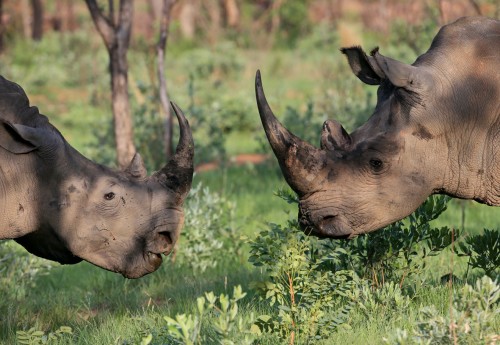By Adam Cruise, courtesy of Conservation Action Trust

South Africa has announced its first decrease in rhino poaching since 2007: “We are pleased to announce that for the first time in a decade the poaching situation in South Africa has actually stabilised and considering that this is in the face of a relentless rise of poaching activity into protected areas – this is good news,” South Africa’s Minister of Environmental Affairs, Edna Molewa said.
At a media briefing in Pretoria, the minister revealed that 1,175 rhinos were lost in South Africa in 2015 – 40 down from the record 1,215 in the previous year.
However, the minister’s ‘good’ news has not been uniformly welcomed.
Dr Morné du Plessis, CEO of World Wildlife Fund (WWF) in South Africa cautioned that while “a decline in the rate of rhino poaching is encouraging, the rate is still too high.” He says the slight dip in figures, which show that poachers are still focusing primarily on South Africa, are “offset by an alarming increase in the number of rhinos killed in neighbouring countries.”
Official figures from Namibia and Zimbabwe for 2015 suggest that criminal networks are expanding their reach across the region – targeting rhinos in previously untouched areas. In Namibia, 80 rhinos were lost to poachers in 2015 – up from 25 in 2014 and just 4 in 2013. In Zimbabwe, 50 animals were killed – more than double the previous year’s total.
Another worry is that the poaching figures come only a day after the South African High Court dismissed the government’s application to appeal an earlier ruling lifting a moratorium on the domestic sale of rhino horns.
Dr Jo Shaw, Rhino Programme Manager for WWF South Africa said the reopening South Africa’s national rhino horn trade will make it even harder for already overstretched law enforcement agents to tackle record rhino poaching.
“The High Court ruling is a serious blow. There is no market for rhino horn in South Africa so lifting the domestic moratorium can only encourage illegal activity, especially as it is likely to be misconstrued as a lifting of the current international trade ban.”
Peter Knights, CEO of WildAid, an international NGO focusing on demand reduction, says he has heard “persistent reports that prominent private rhino owners who contested the moratorium hope to attract east Asian citizens to South Africa to consume rhino horn in-country as a form of “medical tourism.”
“Despite the fact that it is mostly keratin,” he says, “rhino horn is believed by some to be a cure for serious illnesses.”
“Promotion of these disproven properties will not only increase demand in Asia, but customers also will be tempted to take their ‘medicine’ back with them or have it shipped out illegally.”
Molewa said she will apply for leave to appeal to the Supreme Court of Appeal in the rhino horn moratorium judgment which will result in another suspension of the operation and execution of the court’s decision to review and set aside the moratorium.
In other words, the minsiter will once again put the brakes on domestic trade in rhino horn – but only for now.

![Rhino Horn Trafficking: Market-Based Solutions Under Scrutiny [Podcast]](https://annamiticus.com/wp-content/uploads/2015/11/BehindTheSchemesEpisode38_500px-150x150.png)


